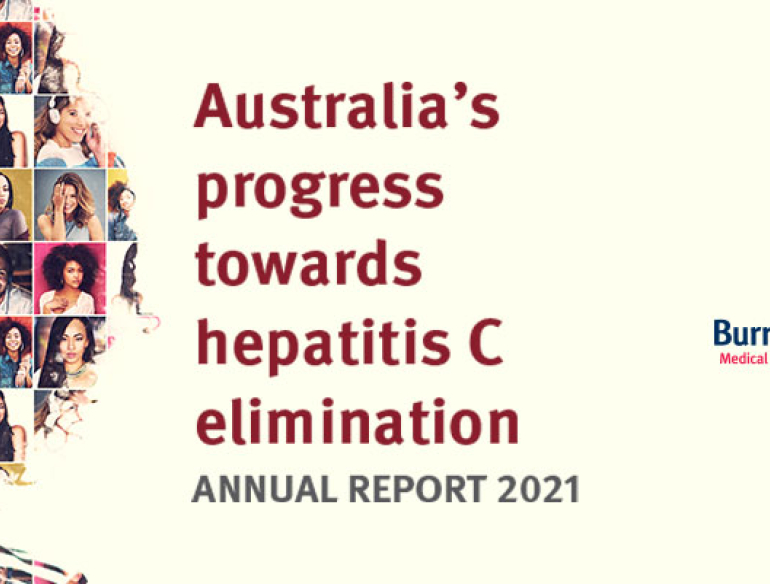A new national report released today highlights a decline in hepatitis C testing and treatment uptake, putting Australia at risk of not achieving its target of eliminating hepatitis C as a public health threat by 2030.
The report 'Australia’s progress towards hepatitis C elimination–Annual Report 2021’ notes an ongoing decline in testing in 2020 for both hepatitis C antibody and RNA testing used to detect infections. The same trend has been observed for the uptake of direct-acting antiviral (DAA) treatment for hepatitis C, with 2020 the first year since the DAA program commenced where less than 10,000 people were treated. Critically, COVID-19 is also likely to be impacting on both testing and treatment uptake.
Since DAA treatment was introduced in 2016, close to 50 per cent of people with chronic hepatitis C infection at that time have been treated. However nearly 120,000 Australians living with hepatitis C still need treatment. There is an urgent need to engage with this group who have not accessed treatments and some of whom may not know they have the infection.
The report’s findings highlight the need for immediate and sustained investment in community, education and clinical programs to increase hepatitis C awareness, testing and treatment. Of note, impact and cost-effectiveness modelling outlined in the report shows such investment would be highly cost-effective in the long-term.
Maintaining testing and treatment rates seen between 2016 and 2020 up to 2030 would prevent 15,700 new infections and 8,500 deaths over 2016–2030. Modelling in the report suggests current investments would become cost-saving by 2022 and have a net economic benefit of AUD$5.7 billion by 2030.
Australia could be one of the first countries in the world to eliminate hepatitis C, however, the report suggests more needs to be done to meet this goal. The further testing and treatment scale-up required to reach hepatitis C elimination targets between now and 2030 would avert an additional 10,000 new infections. This will increase the net economic benefit at 2030 by a further AUD$272 million.
Quote attributable to Professor Margaret Hellard AM, Burnet Deputy Director and infectious diseases clinician:
“Australia has an opportunity to eliminate a deadly virus. The focus now is on getting 120,000 people who live with hepatitis C on treatments which are highly effective, well-tolerated and easily accessible. We need to find more innovative ways to engage with communities and look at how we help those who have undiagnosed and diagnosed hepatitis C to get on to care. This includes simplifying access to treatment, addressing stigma and discrimination and working with peer workers who can better reach priority groups.”
Quote attributable to Burnet Head of Public Health Professor Mark Stoové:
“We are at a critical phase where hepatitis C testing and treatment numbers are falling. An exceptional number of Australians accessed treatments when direct-acting antivirals were first listed in the Pharmaceutical Benefits List, which helped to drive down new infections. But Australia needs to renew, scale up and sustain our efforts. There’s no time to lose. We have to accelerate the momentum and ensure we don’t miss this opportunity to address a major health issue.”
Quote attributable to Scientia Professor Gregory Dore, Kirby Program Head, Viral Hepatitis Clinical Research Program:
“The next few years will be crucial for hepatitis C elimination efforts in Australia. It is absolutely vital major efforts are made to diagnose the undiagnosed and link all people living with hepatitis C to treatment and care services. We have an enormous opportunity to continue to be internationally-leading in our response.”
About the report
Burnet and Kirby Institutes work with research, clinical, community and government partners across the country to produce the annual report on Australia’s progress towards hepatitis C elimination. The third report (2020) compiles data from 19 sources across Australia and provides comprehensive overview of Australia’s progress towards hepatitis C elimination. It evaluates strategies and guides future actions.
Media contacts
Angus Morgan, Manager Media and Multimedia, Burnet Institute
Ph: +61 407 357 253 | angus.morgan@burnet.edu.au
Lucienne Bamford, Media and Communications Manager, Kirby Institute
Ph: +61 432 894 029 | lbamford@kirby.unsw.edu.au
